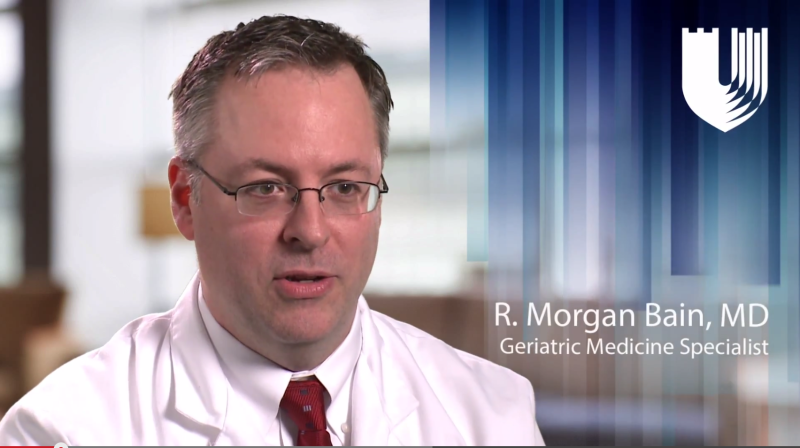
Palliative care physician R. Morgan Bain, MD, FAAHPM is the subject of this week’s faculty spotlight. Bain talks to us about directing the Duke Outpatient Palliative Care Program, meeting the emotional needs of patients new to palliative care, and how his interests in palliative care, geriatrics, and internal medicine inform each other.
How long have you been at Duke? How long have you been at the division of General Internal Medicine?
I have been a member of the Division and Duke Palliative Care since January 2013. Prior to this, I spent six years running the palliative care program at Wake Forest Baptist Medical Center.
What are your responsibilities within the division? What does a typical day for you look like?
My role is that of Medical Director for Outpatient Palliative Care services. Our clinic started in the cancer center in late 2012 and has been expanding ever since. Initially, I would evenly split my time between clinic and the 9300 service as one of the palliative care co-attendings.
With growing clinic volumes and expansion to new locations in Duke South 2B/C, I have been gradually doing more outpatient time. Beyond clinical care of patients, my days are typically filled with teaching of residents and fellows, assisting with various research projects that involve outpatient palliative care, and administrative work.
Can you tell me more about your work as Medical Director of the Duke Outpatient Palliative Care program? How do the services offered for outpatient palliative care differ for inpatient palliative care services?
Outpatient palliative care is a relatively new area of practice in our field across the nation. Very few academic medical centers have had outpatient palliative care services for more than 5-10 years.
The goal of outpatient palliative care is to help patients and their families much sooner in their disease trajectory rather than the last days to weeks of life. We strive to become part of a patient’s care team either at time of diagnosis of a serious illness, or soon thereafter. That way, we can help anticipate care needs, aggressively manage symptoms related to their illness and help with transitions across the healthcare system as their condition progresses.
Compared to inpatient palliative care, we are able to develop relationships with patients and their families over a much longer period of time which I find very rewarding.
In your Duke Medicine Profile you talk about providing a “gentle touch” to help scared or misinformed patients. What sort of fears or misconceptions do you encounter most often? What are some ways that you establish rapport with patients?
When facing one’s own mortality, it can be a time of extreme stress and anxiety. No one approaches it in quite the same manner. When meeting me for the first time in clinic, many patients think I am hospice personified from what they have read online or heard through others. Most often, they do not even know what palliative care is. Once they hear I am there to help them, to understand their needs, worries, and struggles, they begin to open up and start trusting my actions.
In addition to studying internal medicine, you also have interests in palliative care and geriatric medicine. How did these interests develop? How does internal medicine inform each of these areas?
I became interested in geriatric medicine and palliative care when I was a Chief Resident in internal medicine. I attended a conference about improving end of life care education within residency programs and it was a transformative moment with some of the best teaching I have had in my career. That, coupled with the experiences of my grandparents’ declining health, was my calling to help those suffering from chronic and debilitating illnesses.
Being board certified in three disciplines has meant many years of training, but I value each discipline and how they help me provide better care to patients. My daily practice involves caring for patients with complex needs (multiple co-morbidities, polypharmacy, multiple providers, caregiving demands, psycho-social dynamics, etc.) and internal medicine has been the foundation to better understanding their care.
You were a co-author of Fundamentals of Geriatric Medicine: A Case-based Approach, a book published in 2007. Are there plans for a future edition? How has Geriatric Medicine changed since the book was released?
I had the honor to contribute to this book during my geriatric medicine fellowship at Mount Sinai. It was a companion book to the parent text, Geriatric Medicine: An Evidence-Based Approach, by Christine Cassel. From this work, I was asked to contribute test questions regarding pressure ulcer management to the Geriatric Review Syllabus for multiple editions.
Since that time, Geriatric medicine, like palliative care, suffers from a shortage of trained physicians nationwide. Each field has had to adapt and devise ways on providing the necessary skills of caring for older adults and vulnerable patients to primary care providers as well as specialists.
What passions or hobbies do you have outside of the division?
Traveling and food exploration are my main hobbies. I also enjoy attending theater, watching Duke sporting events, and spending time at the beach. My husband, Jonathan, is a theatre director and actor but spent several years as an event planner and restaurateur in the Hamptons and Manhattan before moving to North Carolina.
I have been spoiled with good food ever since we met. Durham was voted “America’s Foodiest Small Town” by Bon Appetit in 2008 and “The Tastiest Southern Town” by Southern Living in 2013 and we have been taking full advantage since moving here.
Jonathan has started his own professional theatre company here in Durham, the Bartlett Theater. His inaugural production of Edward Albee’s “Who’s Afraid of Virginia Woolf?” premieres at the Durham Arts Council’s PSI Theater during the first two weeks in November (shameless plug).
Have you recently read any books, articles, blog posts or other material that would be of interest to the division?
Having re-certified in internal medicine in 2012, I have been intrigued by online discussions and posts from colleagues regarding Maintenance of Certification and the issues surrounding the ABIM, such as this one. Practice improvement modules can prove challenging when working with a predominantly dying population in the hospital setting, but I strongly value life-long learning in some manner.
When not reading clinical material, my tastes encompass historical texts, biographies or science fiction. We recently visited Monticello where I picked up a book, Twilight at Monticello: The Final Years of Thomas Jefferson, which describes the seventeen years he spent out of the public spotlight at Monticello. Reading that history and walking the halls of that special place was a moving experience for me.

Bain and his husband, Jonathan, enjoy a moment in Machu Picchu, Peru.